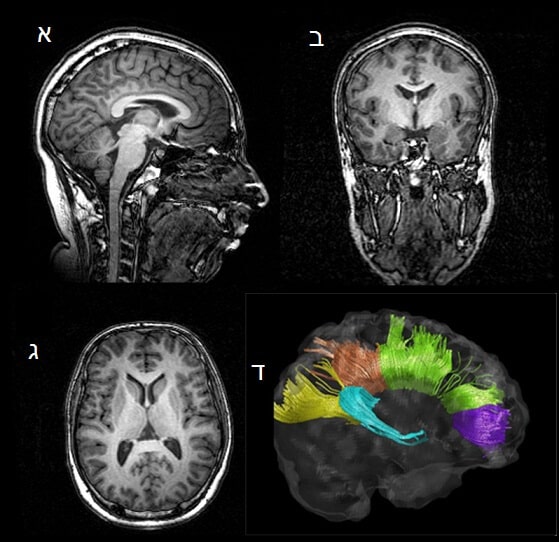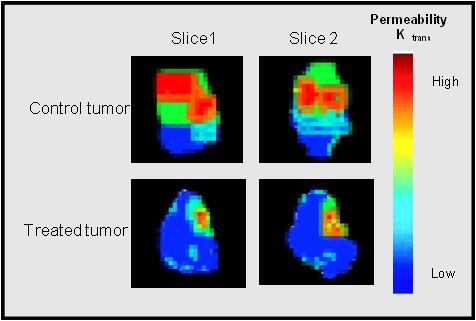MRI or in Hebrew - magnetic resonance imaging is a recognized diagnostic method based on the spin properties of protons. Innovative and diverse applications of this tool improve the ability to diagnose various diseases, allow a specific examination of medical treatment and contribute quite a bit to biomedical research
By: Dr. Efrat Sasson and Dr. Tamar Katzir
Editing of the article: Lehi Kaufman lihik10@gmail.com

Basic disease diagnosis mainly includes clinical assessment of the disease and histological or biochemical measurements of the tissue. Today, more specific diagnostic methods are at the forefront of technology. Various imaging methods, including MRI, enable high-resolution three-dimensional tissue imaging, and provide many quantitative parameters.
Magnetic resonance imaging (MRI) is a non-invasive scan, used to image internal organs in the body without the use of X-rays. The method combines a strong magnetic field (higher than 1 Tesla) and radio waves to affect the spin of the protons in the hydrogen atoms found in the water molecules in the body. The change in spin properties depends on the type of tissue in which it is found. With the help of measuring the spin change, it is possible to obtain a clear separation between the different tissues, and this in all types of sections: sagittal, (division to the left and right side), frontal, (coronal, front and back), horizontal, (axial, upper and lower ) or in 1D reconstruction (Figure XNUMX). The MRI method has been used for several decades to diagnose many diseases, such as multiple sclerosis, cancerous tumors, and spinal disc herniations.
One of the biggest challenges in biomedical research is to define biomarkers, in order to characterize various biological and pathological processes and to test the effectiveness of drug treatment or any other intervention. Advanced MRI scans provide quantitative values that are used as biomarkers. In recent years, MRI methods have been developed advanced, which provide many and varied quantitative indicators.

A major field in which the various MRI methods are widely used is cancer research. One of the classic uses of MRI is tracking the size of a cancerous tumor in 2D, before and after drug administration. Another use of MRI is diffusion weighted imaging (DWI), which provides measures of tissue density. An increase in the values of this scan indicates the death process of cancer tumor cells, even before the reduction of the tumor can be detected, for example after chemotherapy or radiation therapy. (Figure 3). Another fascinating field in tumor imaging is the measurement of vascular permeability in the tumor. Many drugs work to destroy the blood vessels that feed the tumor, thus leading to the death of the cancer cells themselves. Advanced MRI methods allow measurement of blood flow and vascular permeability in cancerous tissue (Figure XNUMX).
Multidisciplinary scanning

As mentioned, advanced MRI methods can provide quantitative indicators, which are biological markers for various biological phenomena, but not only in cancer research. BioImage offers a variety of MRI research services to pharmaceutical companies and researchers in the biomedical field. One of the methods is DTI (Diffusion Tensor Imaging), a method that is sensitive to the density of cells in the tissue. In Alzheimer's disease, for example, there is atrophy, increased death of cells in the brain. In MRI scans using the DTI method conducted by Dr. Tamar Katzir, from the company's headquarters, on genetically modified mice as a model for Alzheimer's, a significant difference was found in the morphology of the cells in the brain between the model mice and normal mice. The change was focused, among other things, in the hippocampus region, which is responsible for memory function, and is known to be affected in Alzheimer's disease. This research was conducted in collaboration with Prof. Danny Michaelson as part of Dr. Katzir's doctoral thesis in the laboratory of Prof. Yaniv Assaf at Tel Aviv University. Dr. Efrat Sasson, a co-founder of the company, in her research compared DTI scans of subjects with normal memory function and scans of subjects who experienced a decline in memory function. The DTI indices were higher in subjects with decreased memory function in the hippocampus region of the brain, which indicates a decrease in brain tissue density in this region. The research was conducted as part of Dr. Sasson's doctoral thesis in the laboratory of Prof. Yaniv Assaf at Tel Aviv University.

The DTI method is also sensitive to subtle and complex changes: in the same study, a match was found between the degree of success of the subjects in math exercises and MRI indicators that are sensitive to the directionality of the tissue in the cingulum fiber system. It is an area of white matter in the brain that connects frontal areas of the brain with areas in the parietal lobe, which are associated with mathematical calculations. Another study, in rats, also examined the correspondence between structure and function. The rats performed a spatial memory task (water maze) and were scanned twice: before and after performing the task. Surprisingly, differences were found between the two scans: after the operation, an increase in tissue density was found. Hence, MRI is sensitive to changes in brain plasticity. From the histological analyzes performed at the end of the experiment, another surprising finding was found: the flexibility of the brain measured by the MRI, probably originates from an increase in the density of astrocytes (Figure 4), the largest and most common cells in the central nervous system, and which have many functions, including the supply of nutrients to the nerve cells.
The MRI method has several advantages over other imaging methods, including the ability to image the same organ with different contrasts. Different contrasts highlight different tissues, and therefore will be sensitive to different disease processes. For example, fatty liver is a disease that affects about 30% of the population. To diagnose it with an MRI, two scans are performed: one is sensitive to water molecules and fat molecules, and the other is sensitive to water molecules only. The focus of the fatty liver is light relative to the tissue. But in the first scan it is difficult to determine whether it is fat formation or damage to the tissue (lacuna) which also appears in a light color. To do this, a second scan is performed, sensitive only to water, in which the signal from the fat is essentially "cancelled". So a fatty focus will look dark while a lacuna will look light. Another example is a stroke. One contrast (T2) is sensitive to pathology caused by the infarct and shows an increase in signal. To determine whether the infarction is caused by blood vessel blockage or bleeding, another contrast (T2*) is used that is sensitive to iron molecules, and bleeding will appear black. Additional contrast (T1) can indicate, after the administration of a contrast agent, blood vessels in which the blood-brain-barrier (BBB) has been breached.
MRI advances clinical studies
The quantitative measures of the MRI can be used as biological markers for changes in the tissue following the administration of drug therapy. The MRI can teach about the mechanism of a disease and thus look for candidates for a molecule that can be used as a medicine. For example, in a study in a cancer model in mice, conducted in Marburg, Germany, a certain gene involved in the formation of blood vessels was silenced. Indeed, using an advanced MRI method, a decrease in the vascular permeability indices was found in these mice, indicating that the tumor has fewer blood vessels compared to control mice, in which the tumor and the blood vessels feeding it developed without interruption. The same protein that the gene for its creation was silenced, was defined as a candidate to bind to it a drug that would destroy the blood vessels in the tumor and thus lead to the death of the cancer cells. Also, since advanced MRI methods allow obtaining quantitative variables, they can be used as a means of comparison between combinations of different treatments and between different doses of treatment.
Another area is functional MRI, which makes it possible to measure brain activity after drug administration in a non-invasive manner. This is through the functional MRI method, fMRI (functional MRI). The signal measured by the fMRI method is determined by local changes in the ratio between the oxygenated hemoglobin and the non-oxygenated hemoglobin. This ratio indicates the area where brain activity increases. This method makes it possible to map the effects of drugs on the activity of neural networks in the brain, both by measuring the brain's activity at rest, before and after the administration of the treatment, and by measuring the brain's activity while performing some task.
A new field that has developed in recent years is nanomagnetic particles. These particles make it possible to mark cells or molecules; If they are attached to a molecule used to treat, for example, cancer, they are used in two roles: as drug carriers directly to the target organ, and as markers that enable monitoring via MRI of the migration of the drug in the body to verify that it has indeed reached the target organ. This has many uses, for example when the means of treatment is stem cells. The cells are usually injected into an animal, but to be sure that they have reached the target organ, they are attached to the nanomagnetic particles and after the injection, an MRI scan is performed: the magnetic particles cause a change in the signal received by the device, and thus these cells can be tracked. MRI is also used in the development of medical devices: it is possible to examine the position of an implant or a device in the tissue, and here too it is possible to obtain quantitative indicators that teach about the therapeutic process.
Because MRI enables impressive visualization and presents results relatively quickly compared to traditional methods in research, it can assist decision-making processes at important junctures in medical research. Correct decisions in the early stages of research can save a lot of resources. It is possible to obtain convincing and impressive initial results at an early stage and thus help in raising resources for research.
The BioImage company, under the management of Dr. Tamar Katzir and Dr. Efrat Sasson, is the only company of its kind in Israel that offers pharmaceutical companies and researchers in the biomedical field MRI research services, including advanced MRI methods, which provide a variety of biological markers to characterize tissues and diseases and to examine the effectiveness of medicines or different treatments. In the short time it has existed, the company has managed to conduct MRI studies for customers in the biomedical industry and academia. Among its clients are leading companies in the economy in many fields, such as vascular diseases, cancer research, and more, and leading academic researchers in the fields of autoimmune diseases, cerebral palsy, psychiatric diseases, and more.
www.bioimage.co.il
Info@bioimage.co.il
Efrat Sasson 054-7890639
Tamar Katzir 054-6257724

One response
A beautiful article, which highlights only part of the potential of MRI. Recently, surgery using focused ultrasound (which cannot be performed without MRI) made headlines, and the sad thing is that this technology (also the result of Israeli development - http://www.ted.com/talks/yoav_medan_ultrasound_surgery_healing_without_cuts.html) will not progress if there is no discount on MRI devices, which there is still a serious shortage in Israel.
If only the title could be corrected, “Magnetic resonance imaging is a recognized diagnostic method based on the spin properties of electrons. "In MRI, they work on the spin of the protons (written later in the article) and not on the electrons.